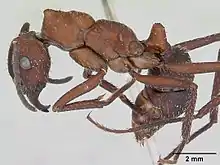Ectatomma opaciventre
Ectatomma opaciventre is a South American species of ant from the subfamily Ectatomminae. In the Brazilian savannah, nests occur at low density and in specific microhabitats.[1]
| Ectatomma opaciventre | |
|---|---|
 | |
| Scientific classification | |
| Domain: | Eukaryota |
| Kingdom: | Animalia |
| Phylum: | Arthropoda |
| Class: | Insecta |
| Order: | Hymenoptera |
| Family: | Formicidae |
| Genus: | Ectatomma |
| Species: | E. opaciventre |
| Binomial name | |
| Ectatomma opaciventre (Roger, 1861) | |
| Synonyms | |
| |
Basic biology
E. opaciventre is polydomous.[2] Nests are excavated in soil and can be up be up to 68 cm deep, and comprise multiple sub-chambers.[3]
Foraging ecology
The foraging ecology of E. opaciventre has been studies in detail. Workers forage diurnally, scavenging and predating live arthropods (primarily leaf cutter ants and termites). Opportunistically consuming dead and alive animal protein is typical of Ectatomma. However, E. opaciventre has the least diverse diet of studied ants from the genus, and unlike others, does not collect liquid food. They forage individually, and show individual-level spatial fidelity in foraging habits ('path fidelity').[1]
Behavior
Temporal polyethism
E. opaciventre exhibits temporal polyethism, with young workers performing more brood care and allogrooming than older workers.[4]
Nest relocation
In response to disturbance, ants may migrate nest. Various mechanisms are used by different species, including tandem running, pheromone trail laying, and 'adult transport' where workers carry adult nest-mates. E. opaciventre shows exclusively adult transport, with workers (and winged gynes) carrying workers, winged gynes, queens and males. This differs from other closely related species e.g., E. quadridens, which lay trails.[5]
References
- M. R., Pie (2002). "Foraging ecology and behaviour of the ponerine ant Ectatomma opaciventre Roger in a Brazilian savannah". Journal of Natural History. 38 (6): 717–729. doi:10.1080/0022293021000041699. S2CID 85171315.
- Tofolo, Viviane C.; Giannotti, Edilberto; Neves, Erika F.; Andrade, Luis H. C.; Lima, Sandro M.; Súarez, Yzel R.; Antonialli-Junior, William F. (2014). "Polydomy in the ant Ectatomma opaciventre". Journal of Insect Science. 14: 21. doi:10.1093/jis/14.1.21. PMC 4199536. PMID 25373168.
- Antonialli-Junior, W. F.; Giannotti, E.; Neves (1997). "Nest architecture and population dynamics of the Ponerinae ant, Ectatomma opaciventre Roger (Hymenoptera : Formicidae)". Journal of Advanced Zoology: 64–71.
- M. R., Pie (2002). "Behavioral Repertoire, Age Polyethism and Adult Transport in Ectatomma opaciventre (Formicidae: Ponerinae)". Journal of Insect Behavior. 15: 25–35. doi:10.1023/A:1014475927822. S2CID 19570362.
- Overal, W. L. (1986). "Recrutamento e divisão de trabalho em colônias naturais da formiga Ectatomma quadridens (Fabr.) (Hymenoptera: Formicidae: Ponerinae)". Bol. Mus. Para. Emilio Goeldi.
- Hölldobler, B.; Wilson, E. O. (1986). "Ecology and behavior of the primitive cryptobiotic ant Prionopelta amabilis (Hymenoptera: Formicidae)" (PDF). Insectes Sociaux. 33: 45–58. doi:10.1007/BF02224034. S2CID 11779171.